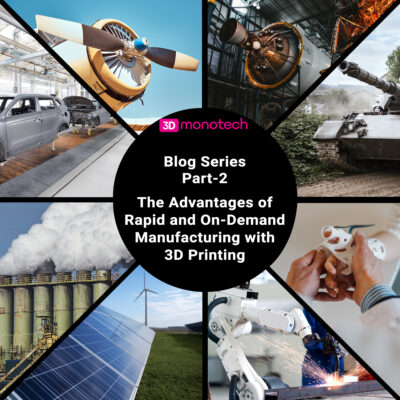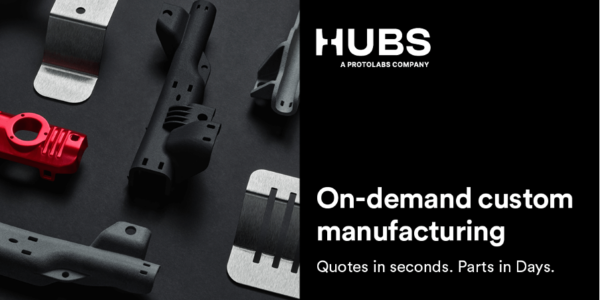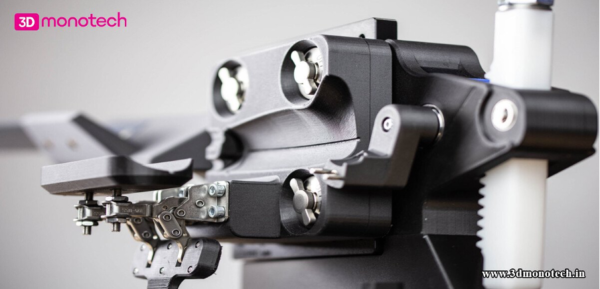Blog Series
Part-2

As technology continues to evolve, businesses must stay up-to-date with the latest trends and innovations. Today, we are living in the age of Industry 4.0 or the fourth industrial revolution that refers to the integration of digital technologies, such as the Internet of Things (IoT), Artificial Intelligence (AI), and automation, with manufacturing processes like 3D Printing. 3D printing is an essential part of Industry 4.0 as it delivers a host of advantages including enablement of rapid and on-demand manufacturing.
The adoption of rapid and on-demand manufacturing processes provides numerous benefits to businesses seeking to optimise their manufacturing operations. With its virtually limitless design capabilities, this approach not only minimises material waste but also facilitates on-demand manufacturing, making it a highly attractive proposition for companies striving to streamline their production processes.
Rapid and on-demand manufacturing is only one among several benefits that 3D printing offers. By integrating 3D printing into their manufacturing workflow, businesses can reap numerous advantages, such as cost savings, enhanced product design, and the ability to customise and personalise products.
In this article, we will explore the benefits obtained by harnessing the formidable capabilities of 3D printing for Rapid and On-Demand Manufacturing. Moreover, we will illustrate real-world instances of its practical integration across a wide range of industries.

Hubs On-Demand Manufacturing platform/Source: Hubs
Rapid and On-Demand Manufacturing
Rapid and On-Demand Manufacturing are two distinct but closely related concepts that are gaining traction in the manufacturing industry.
Rapid Manufacturing refers to a group of manufacturing technologies and techniques that allow businesses to quickly produce small quantities of parts or products, typically without the use of expensive tooling or moulds. Rapid manufacturing technologies primarily include 3D printing, but they can also include subtractive technologies.
On-Demand Manufacturing is a manufacturing system that enables businesses to produce and deliver products to customers as orders come in, as opposed to producing large quantities of products in advance and storing them in a warehouse. This system is made possible by advances in digital technology, such as 3D printing, which enables businesses to create customised products without the use of moulds using only digital CAD files that can be uploaded to the 3D printer and printed at will. The on-demand manufacturing system can help businesses reduce inventory costs and improve customer responsiveness.
Advantages of 3D Printing in Rapid and On-Demand Manufacturing
Rapid and Cost-Effective Manufacturing
Traditional manufacturing processes can be time-consuming and costly, while 3D printing, on the other hand, allows for rapid and cost-effective manufacturing. Businesses can use 3D printing to create a digital CAD design of their product and get it 3D printed in a matter of hours or days. This method eliminates the need for moulds, which reduces costs and production times significantly.
Furthermore, because of the exceptional adaptability inherent in 3D printing, businesses can incorporate changes into their designs quickly and easily. This enables businesses to respond to customer feedback quickly and effectively, accelerate the iterative process, and seamlessly modify their products without incurring additional costs.
Limitless Design Capabilities

Personalised 3D printed fingerprint stool/Source: BigRep
Traditional manufacturing processes have inherent design limitations but these can be overcome by leveraging the power of 3D printing technology. A notable example of this is the impressive achievement by BigRep, wherein they successfully conceptualised and 3D printed a remarkable personalised fingerprint stool. This extraordinary piece of furniture showcases a distinctive design, incorporating the fingerprint impressions of Dr. James Novak, a renowned Research Fellow specialising in additive manufacturing at Deakin University, and his wife.
The stool’s highly-organic structure elegantly intertwines the intricate ridges of the fingerprints, skillfully weaving support structures through the void spaces before seamlessly merging in the open mid-section of the design.
This showcases the limitless design and manufacturing capabilities one can extract from 3D printing.
Reduced Material Waste

BigRep’s NERA Bike/Source: BigRep
Traditional manufacturing processes often result in substantial waste generation. Take for example a simple lathe machine that does turning operations to round off parts. This process generates a ton of debris.
In contrast, 3D printing presents a highly efficient approach that mitigates material waste. By adopting 3D printing, businesses can manufacture products precisely how they are needed. By incorporating topology optimisation and lightweighting techniques, the weight and essentially the material usage can be reduced without affecting the strength and function of the part. All this contributes to reducing the material wastage.
A noteworthy illustration of this is the remarkable achievement by BigRep in the creation of the NERA bike. This ground-breaking achievement showcases a fully customised bike, with a noteworthy feature being its airless tire. According to Michelin, 3D printed tyres will help to reduce the waste generated by the approximately 200 million rubber tyres that are discarded prematurely each year due to puncture damage, improper air pressure, and other common forms of wear. Furthermore and as explained earlier, the technology also aids in reducing waste production during the manufacturing process, doubling the impact.
Customisation
Rapid and on-demand manufacturing does not impede customisation, in fact it can be as easily incorporated in the manufacturing process. Consider how WePrint, a Czech 3D printing service provider, collaborated with a client – NF Aircraft – who had an unusual request for a customised dashboard for their turboprop aircraft. As the dashboard has a very complex shape, traditional processes were prohibitively expensive, rendering the entire project unviable. As a result, the team decided to 3D print the dashboard, which they did using a Markforged 3D printer and the Onyx material. The onyx material provided the exact characteristics they required: accuracy, flexibility, and a surface finish suitable for a final product.
More Production Flexibility

A 3D printed fixture that was used in conjunction with an Instron test frame to translate linear force into rotational force to press (and measure) button actuation on a medical device
3D printing is revolutionising manufacturing by allowing for unprecedented production flexibility, which benefits both manufacturers and sellers. Traditional manufacturing service providers frequently face the problem of declining orders because quantities fall below their minimum order threshold, rendering them unprofitable. This limitation, however, has been effectively overcome with the advent of 3D printing.
Because 3D printing eliminates the need for costly tooling stages, manufacturers can now fulfil lower-quantity orders. This newfound agility allows them to deliver products in previously unthinkable quantities. Simultaneously, sellers are no longer limited by their traditional equipment capabilities. They can provide a diverse range of parts to customers from prototypes to end-use applications thereby increasing their revenue streams.
Pipeline Design & Engineering, a US-based developer of custom manufacturing equipment, test fixtures, and automation for businesses, for example, had a few SLA printers for printing parts. While they did an excellent job, the maintenance took a long time. They purchased Markforged’s Mark Two 3D printer in order to improve efficiency and reduce maintenance. This investment was a huge success, with the printer demonstrating exceptional reliability and a low failure rate.
Aaron Moncur, founder of Pipeline Design & Engineering, expressed his satisfaction, stating, “I was amazed at how reliable it was — essentially zero failures. We printed over 100 parts before encountering our first issue. It required very low maintenance, a significant departure from the other 3D printers I had dealt with.”
The use of 3D printing not only facilitated the quick and low-cost production of prototypes and custom solutions for customers, but it also created a new revenue stream through the sale of 3D printed parts. Aside from cost savings, Pipeline Design & Engineering significantly increased their production flexibility, allowing them to accept a wider range of orders, fulfil them more efficiently, and save significant sums of money.
Conclusion
The introduction of 3D printing technology has transformed the manufacturing landscape by enabling cost-effective, customizable, and long-term production capabilities. Businesses can optimise their manufacturing processes by incorporating 3D printing into their workflows, reducing material waste and embracing on-demand production methods.
To learn more about 3D printing technology and its potential benefits for your business, we invite you to contact 3DMonotech, a leading provider of cutting-edge 3D printing solutions in India. Our team of 3D printing technology experts is ready to address any concerns, challenges, or questions you may have about the adoption and implementation of this transformative technology. Don’t put off your 3D printing project any longer—join the manufacturing revolution today.
Contact 3DMonotech today to explore the limitless possibilities of 3D printing for your company.



